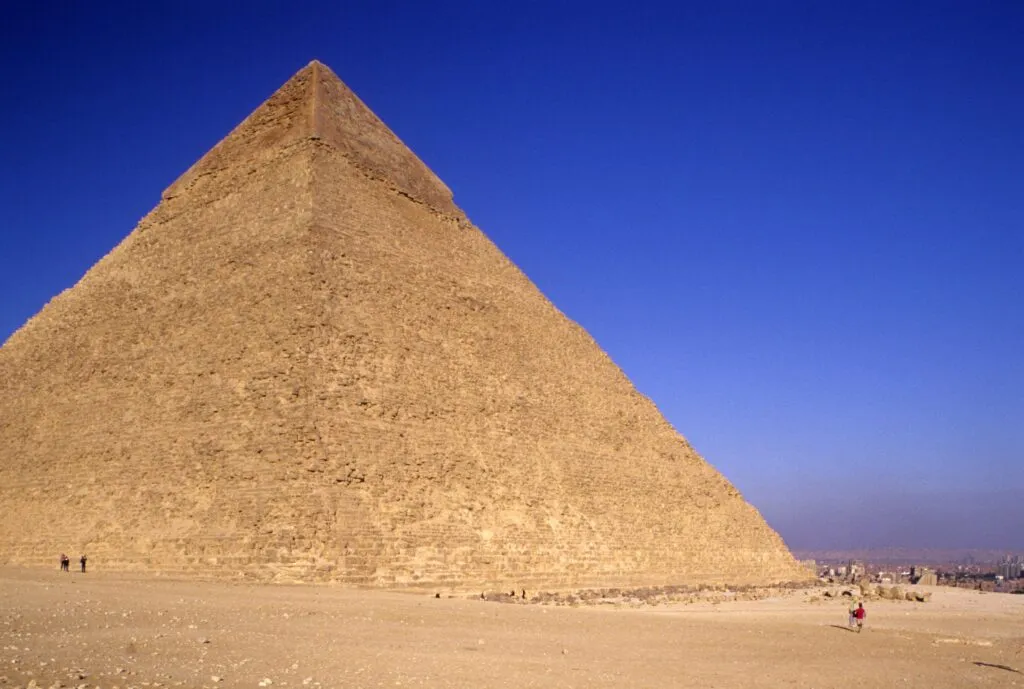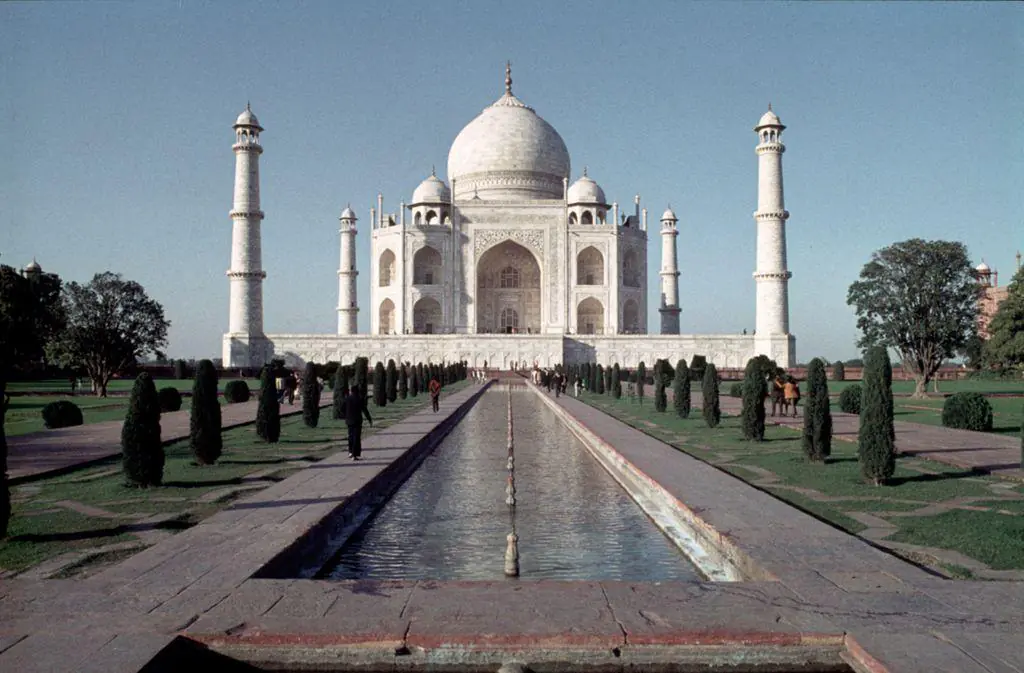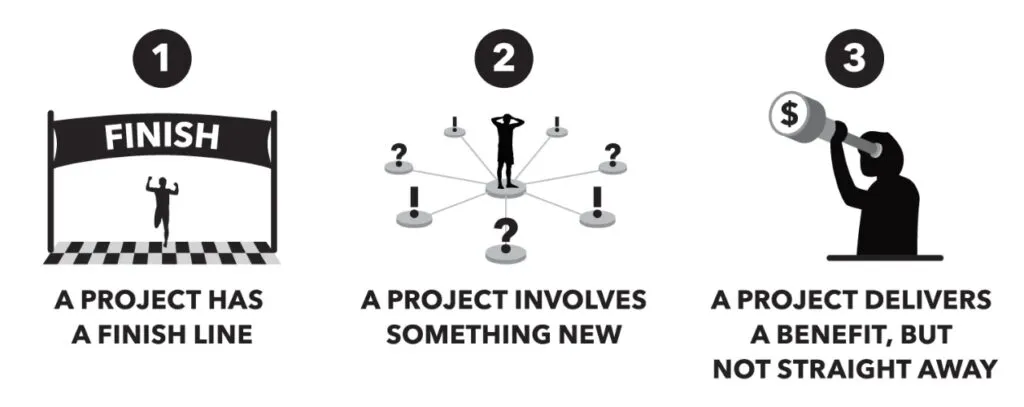This article explains, through interesting examples, the definition of a project. Knowing the definition of project will help you differentiate a project from operation. Each project has unique characteristics which differentiates it from other business operations.
In this article, we will define the project, understand its unique characteristics and learn the difference between operation and projects.
Project examples from history
Great Pyramid of Giza, ancient Egyptian pyramid, was built by Khufu, the second king of Egypt’s 4th dynasty and was completed in the early 25th century BCE. The Great Pyramid is one of the largest buildings ever constructed. It is about 449 feet tall, the base and three sides each measure 755 feet in length. Approximately 2.3 million blocks of stone were cut, transported, and assembled to create the 5.75-million-ton structure, which is a masterpiece of technical skill and engineering ability.

Indeed, pyramid of Giza was temporary endeavor and it was suggested that more than 20,000 workers, with accompanying support personnel (physicians, priests, cooks etc.), would have been marshaled to complete this mega structure.
Taj Mahal, was built by Mughal emperor Shah Jahan, is India’s most famous and widely recognised building. In its harmonious proportions and its fluid incorporation of decorative elements, the Taj Mahal is distinguished as the finest example of Mughal architecture, a blend of Indian, Persian, and Islamic styles. The construction of this massive 42-acre complex spanned 22 years.

Indeed, Taj Mahal was temporary endeavor and it was suggested that more than 20,000 artisans, labourers and painters were involved in the construction of the building. In all, 28 types of precious and semi-precious stone were inlaid into the white marble. A 15 km (9.3 mi) long earthern ramp was built to transport marble and materials to the construction site, hauled on specially constructed wagons by teams of oxen and elephants.
What these two monumental structures which stand testament of human ingenuity, creativity and extraordinary team work tell us?
They are projects. They were temporary endeavor undertaken to create unique product. These temporary endeavors involved careful planning, took fixed number of days to complete ,and had varied stakeholders with their varied interests.
Project Management – a formal definition
Let’s formalise the definition of project.
A project is temporary endeavor undertaken to create unique product, service, or result
Project Management Body of Knowledge, Project Management Institute, 2021
Dr J M Juran – quality guru also defines a project as,
A project is a problem scheduled for solution
Dr J M Juran
Consistent with this definition Great Pyramid of Giza and Taj Mahal were some of the finest examples of projects undertaken in human history.
Modern project management, however, is usually said to have begun with the exceptionally large, complex research and development projects like building a submarine or similar military weapon system. Massive construction programs were also organised as projects, including construction of dams, ships, refineries and highways.
As the techniques of project management were developed, mostly by military, the use of project organisation began to spread. Private construction firms found that organising work based on projects was helpful even on small projects, such as building a warehouse or an apartment complex. Automotive companies use project management to develop new automobile models.
Learn what it takes to become project manager. Top 15 essential Project Management Skills Every Project Manager Must Have
More recently, the use of project management by organisations producing services rather than products, has grown rapidly. Advertising campaigns, event management, mergers and acquisitions are often handled as projects. Project management is not only restricted to businesses, but also non-profit organisations handle their campaigns as projects.
Characteristics of Projects
There are three universal characteristics that all projects share.
The first universal characteristic is that every project is unique. Taj Mahal was a unique project. Great Pyramid of Giza was a unique project. No two construction or R&D projects are alike. Though construction projects are usually more routine, some degree of customization is always involved. For e.g. a different construction sites will entail its own peculiar set of challenges making a project unique so to say.
The second universal characteristic is that project has well-defined and specific desired end result. Referring to our examples, the two projects from a history, when the king had conceptualized these projects, they must have had a clear end vision of a product.
These end results are referred to as project scope. In order to achieve this end-result, a project is divided into tasks and sub-tasks that must be accomplished to achieve the project scope. Each task is complex enough that require careful coordination and control of timing, cost and inter dependency among the tasks.
The third universal characteristic of project is that they have finite duration. There is clear date when project is launched and when it is supposed to be finished – known as project deadline.

Image Source: Project Management QuickStart guide – Chris Croft
Projects Vs Operations
Operations are on going. They are not unique. Since they are on going, they do not have fixed duration, start or end date.
A vehicle production is operation. It is on going, churning out the automobiles day in and day out from its assembly line. A chemical process, petroleum refinery process is operation. It is on going.
Operations are day to day activities that ensure business runs effectively. Unlike projects, operations don’t aim to produce anything new but to maintain and sustain a system. Once automobile plant is set-up, the same vehicle model will roll out every day.
Operations are core business functions (i.e. procurement, finance, accounting, sales, marketing etc.) which are permanent in nature and don’t produce anything new.
Summary
In this article we looked at a definition of project. A project is temporary endeavor undertaken to create unique product, service, or result. There are three universal characteristics of all projects – every project is unique, has well-defined and specific desired end result and has finite duration.
We also learned that projects are temporary and operations are continuous.
Its your turn
Find out three examples of projects and operations from your company. Check how each project follows three universal characteristics we learned. Post your answer in the comments section. I will be happy to read your comment.
References
Here are the resources if you want to go deeper.
- Project Management QuickStart Guide, Chris Croft
- Project Management Body of Language
- Project Management – A Managerial Approach, Scott Shafer, Wiley, 2021




